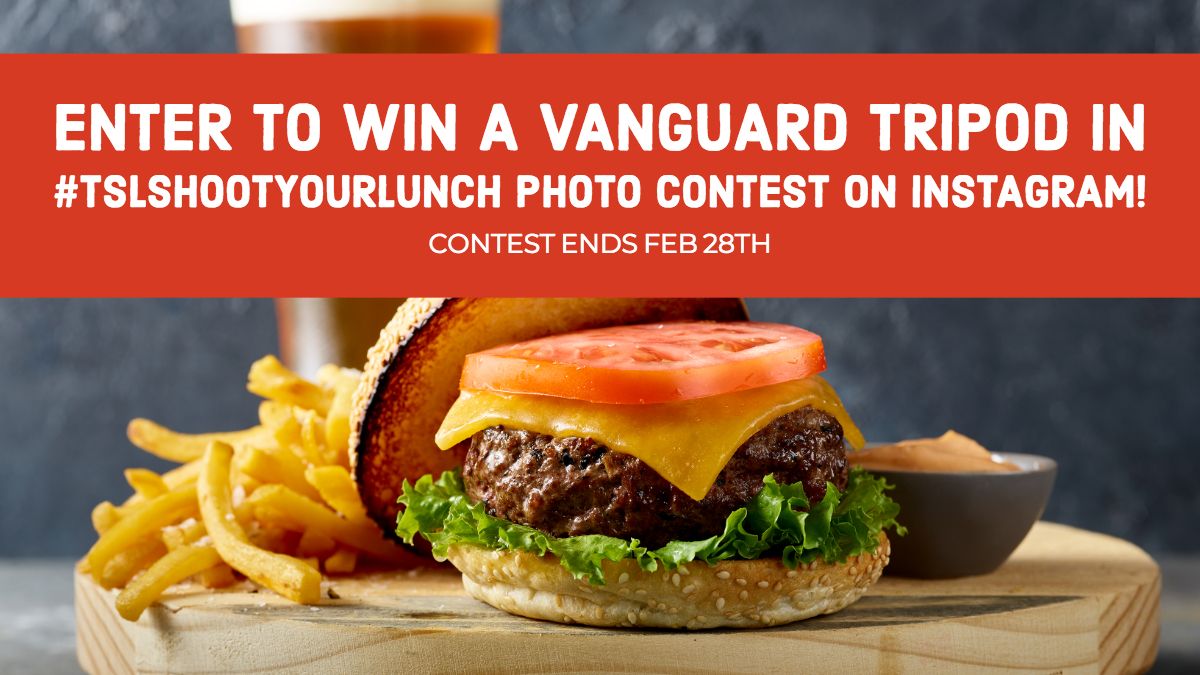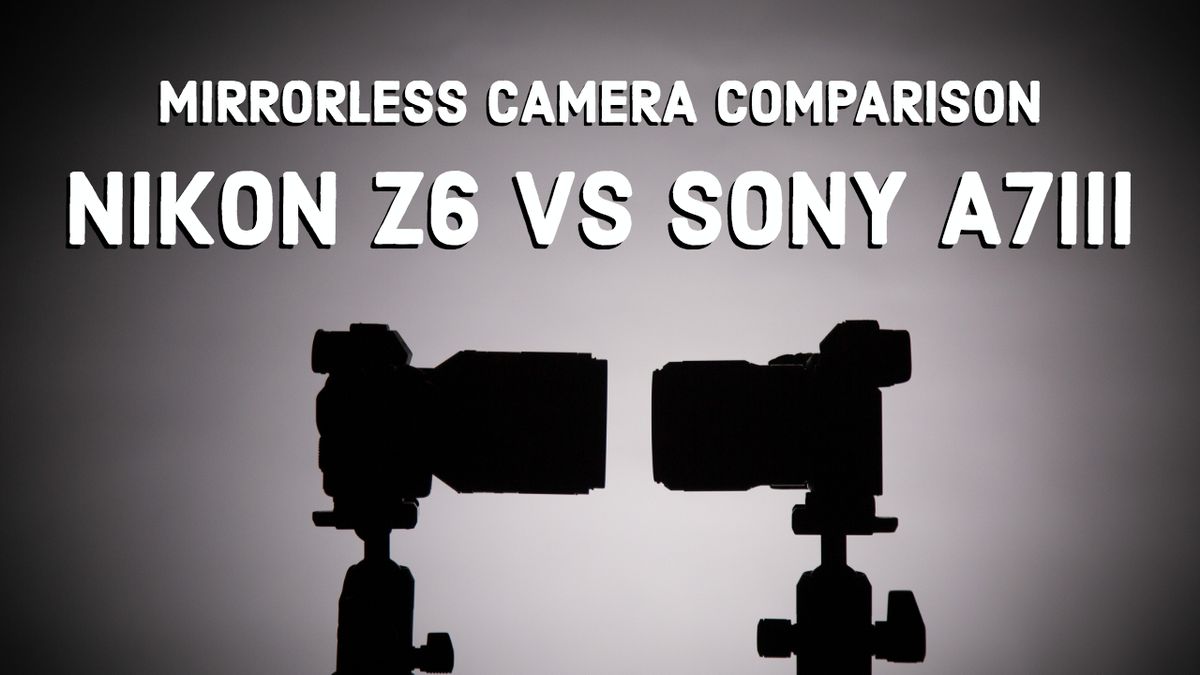 On paper, these two cameras look very similar in terms of specs, but we wanted to test out the results for both of these cameras.
On paper, these two cameras look very similar in terms of specs, but we wanted to test out the results for both of these cameras.
Picture Quality
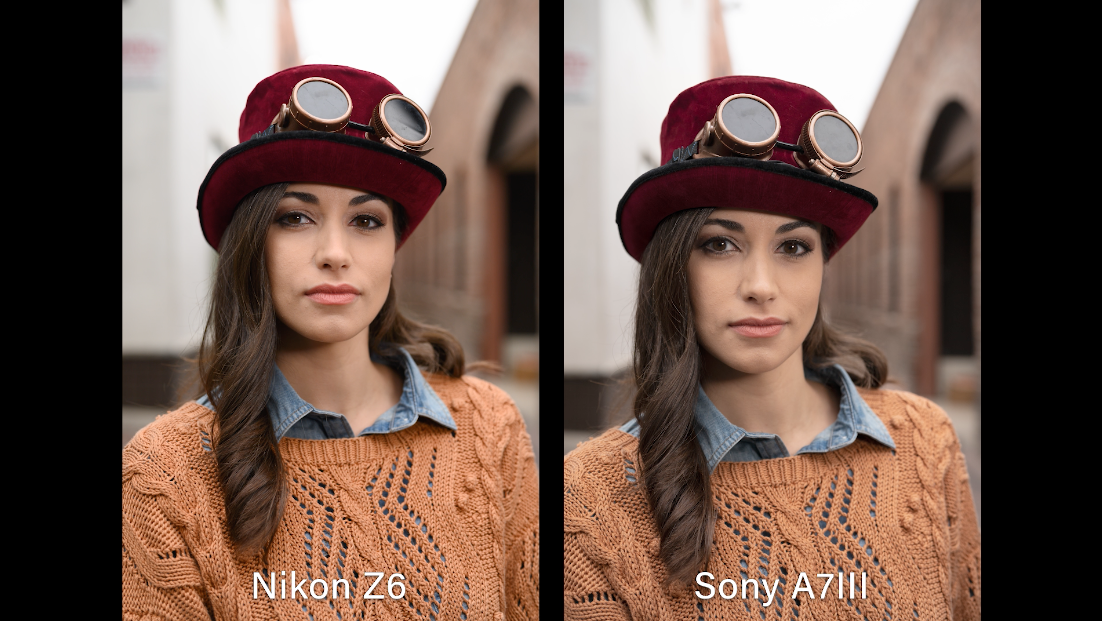 We are going to take a look at her face and skin tone. When we take a look at the color tones, I prefer the warmer tones on the Nikon opposed to the Sony, which has a cooler tone. I did boost the exposure on the Sony by 1 stop, so it’s a little bit darker.
We are going to take a look at her face and skin tone. When we take a look at the color tones, I prefer the warmer tones on the Nikon opposed to the Sony, which has a cooler tone. I did boost the exposure on the Sony by 1 stop, so it’s a little bit darker.
Dynamic Range
For this test, we are exposing for her face as our base exposure and then we are going to overexpose a few stops and underexpose it. The background has a white wall with the sun shining down on it and some bright sky as well, and then we have a darker shadowy wall on the right.
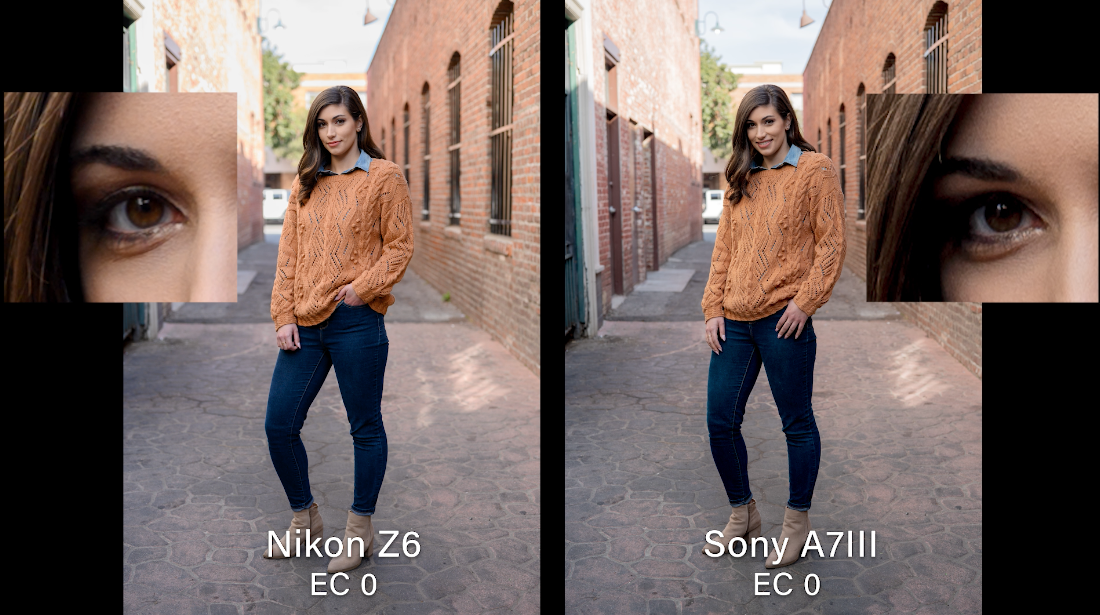 EC 0
EC 0
With the proper exposure set on her face, the Nikon is already blowing out the wall and the sky behind her. Across the board, the Sony exposes 1 stop darker than the Nikon, so we shot according to our meter and then we had to boost all the images that we took on the Sony later.
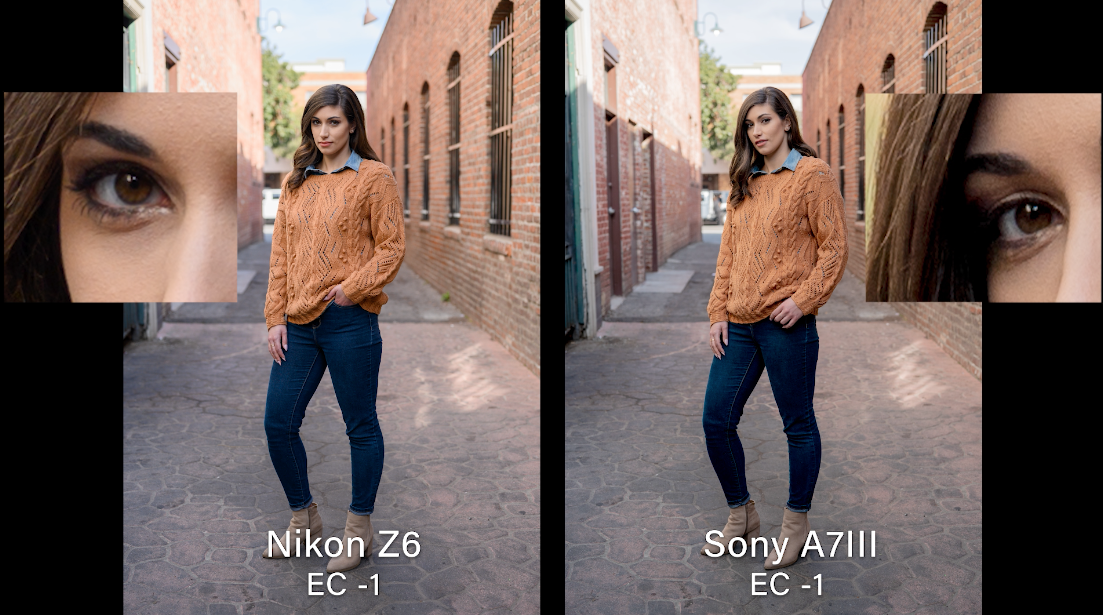 EC -1
EC -1
I really like how both of the cameras look when we underexpose by 1 stop the image and then push it later. The image looks pretty good on both of the cameras.
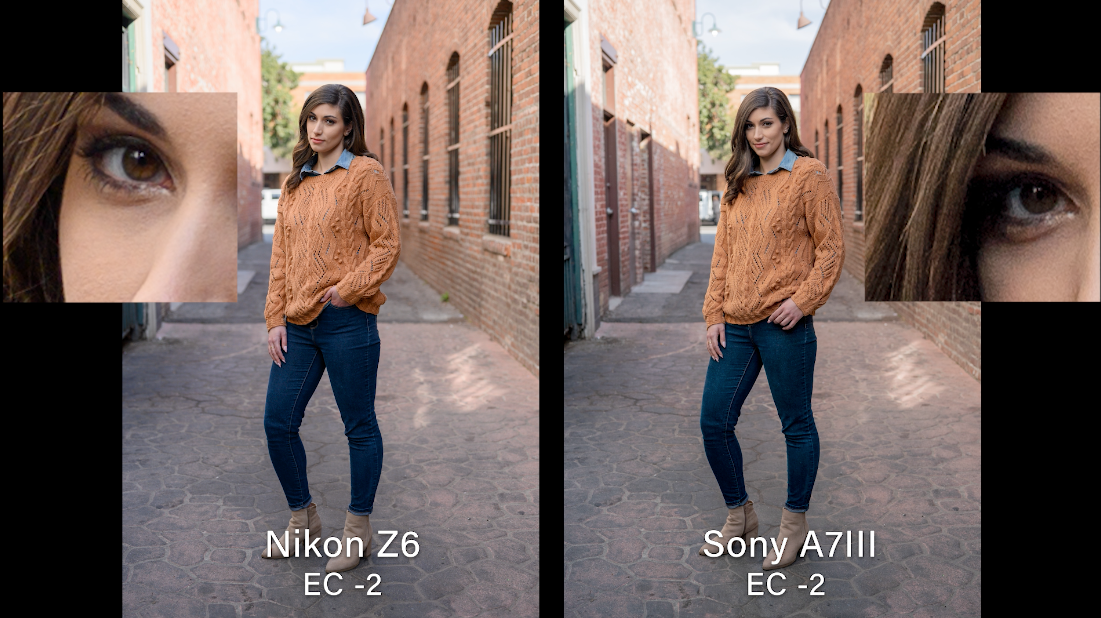 EC -2
EC -2
They look pretty similar at -2 stops of exposure as well. I’m surprised at how well the clips match in terms of the color. The Nikon is a bit more magenta, but we didn’t make any color adjustments to these images yet.
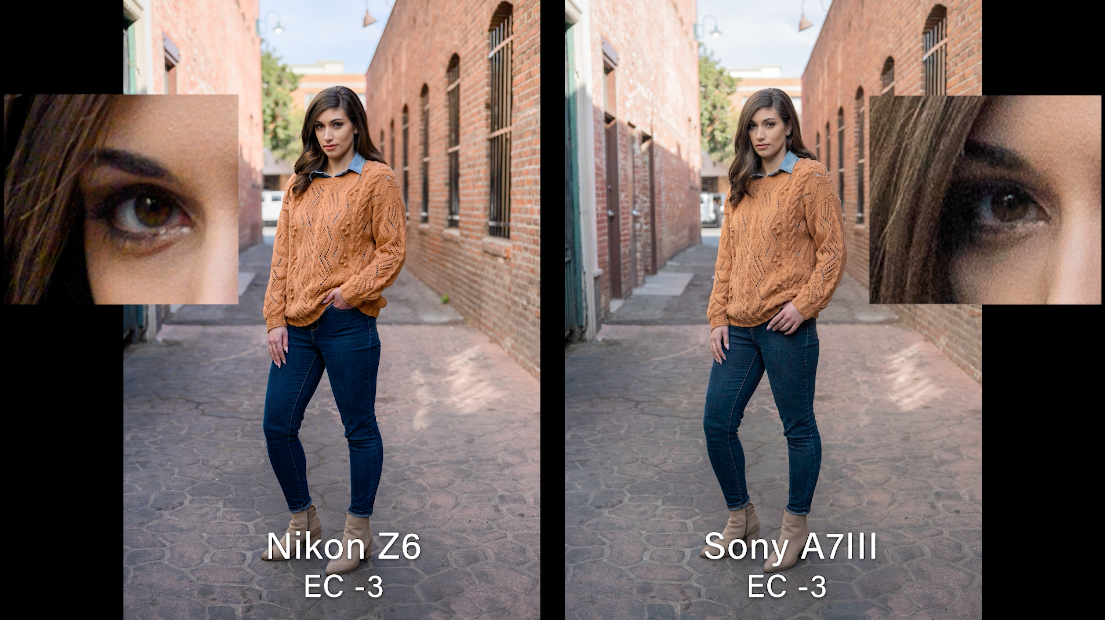 EV -3
EV -3
The Sony starts to look less saturated here in comparison to the Nikon Z6. It’s also starting to get a little grainy.
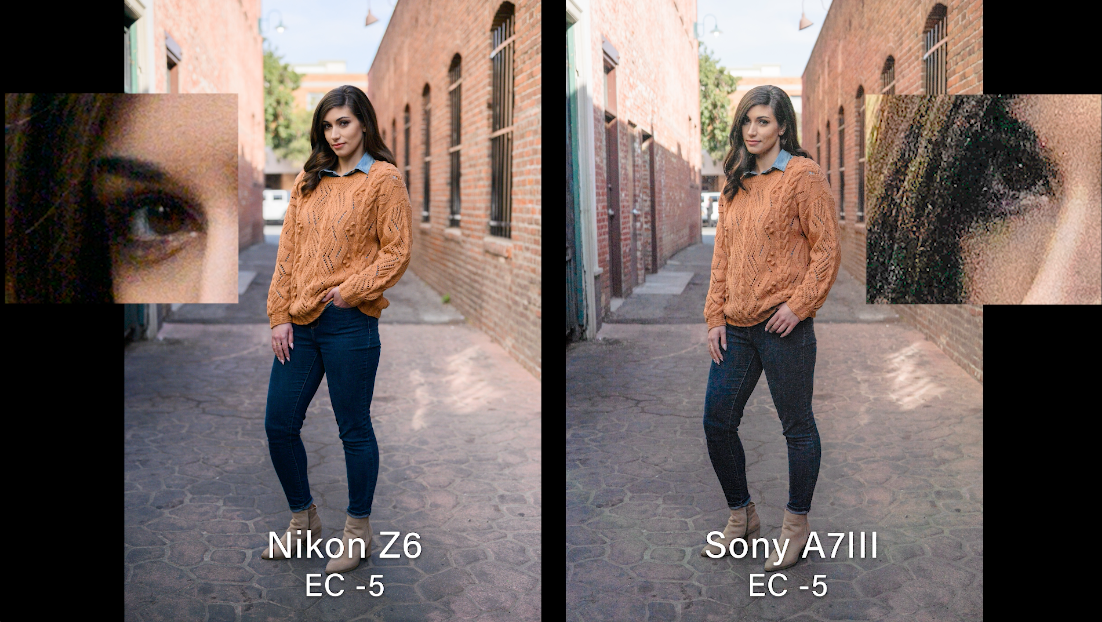 EC -5
EC -5
These images are almost black before you correct them in post-production, but the Sony image has really fallen apart. The grain has really built up, but the Sony is one stop darker because they’ve overrated it. S essentially, it’s 6 stops under.
 What our results have shown is that you are going to have better low-light capabilities with the Nikon. The Nikon -4 is similar to the Sony -3 in terms of the amount of grain in the image.
What our results have shown is that you are going to have better low-light capabilities with the Nikon. The Nikon -4 is similar to the Sony -3 in terms of the amount of grain in the image.
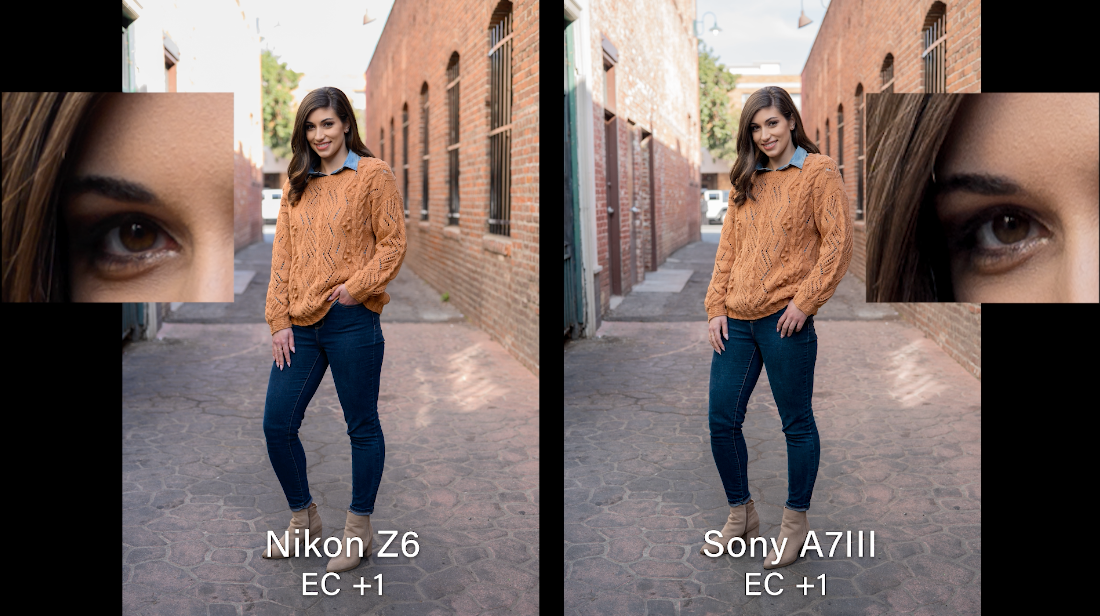 EC +1
EC +1
With overexposing the image, the Nikon Z6 is already blowing out the whites on the wall completely. Sony is doing pretty well, you can still see the detail of the brick wall and the sky.
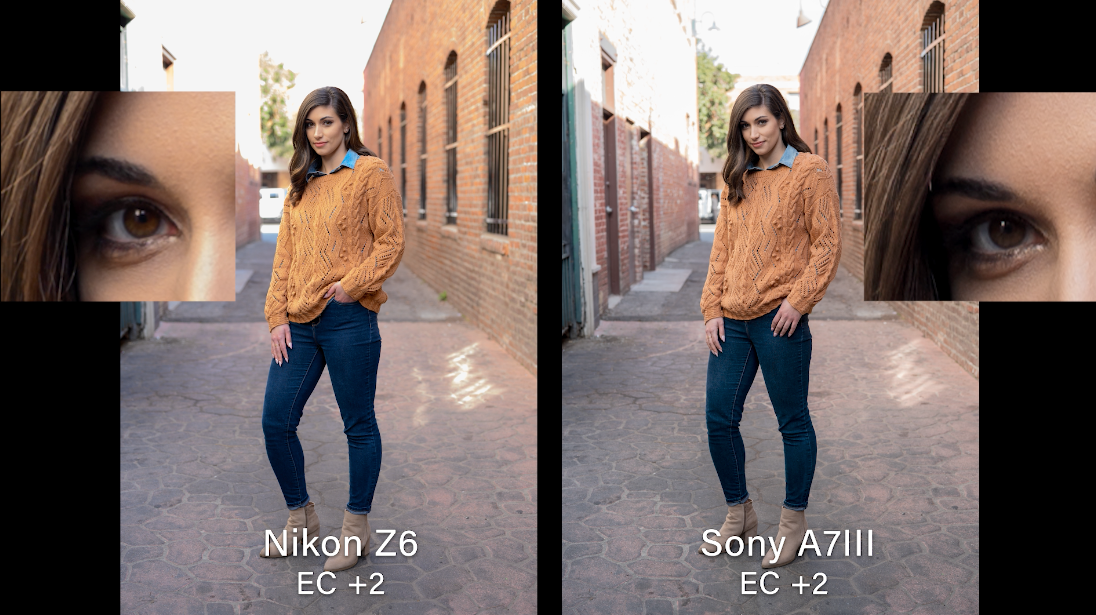 EC +2
EC +2
On the Nikon Z6, more of the wall has disappeared and there is slight clipping that is occurring on her nose. Sony is still holding her face quite well, but the background is blowing out as well.
EC +3
Here the Nikon is completely blown out, but she’s looking pretty good in the Sony.
It seems that the EC 0 on the Nikon is very similar to the Sony EC +1. Sony is holding the highlights a little bit better. The Dynamic Range is similar on both the cameras, but the way that it’s distributed is different because of the way they rate the sensor.
ISO Test
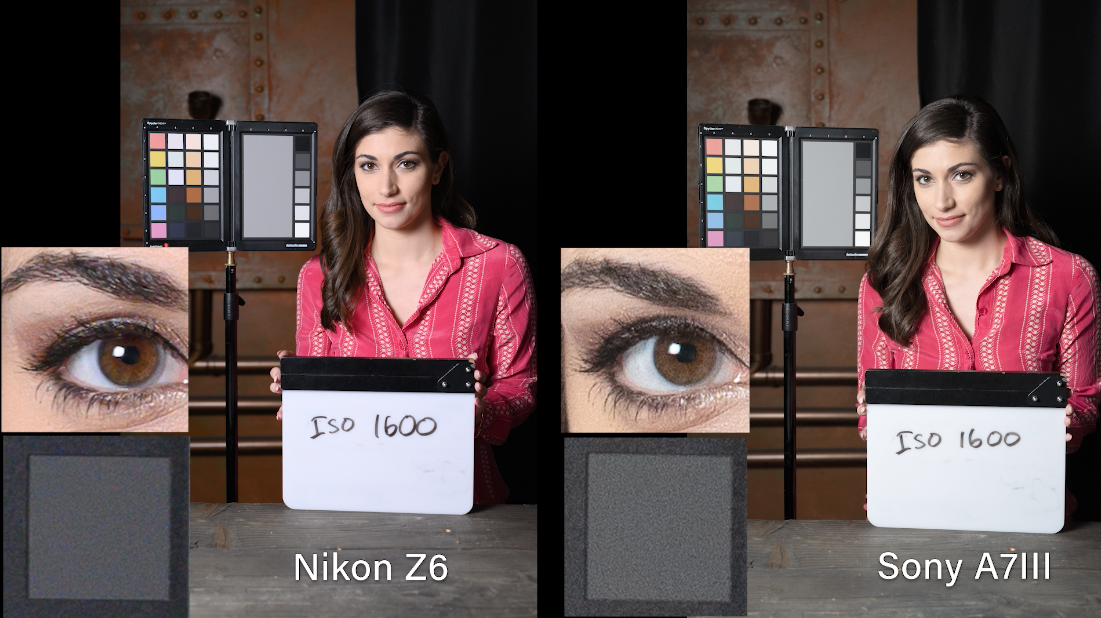 We are starting off with the ISO 1600 and we bumped the exposure on the Sony by 1 stop for all the images. The Sony looks a little bit greener than the Nikon, and there is a bit of grain as well.
We are starting off with the ISO 1600 and we bumped the exposure on the Sony by 1 stop for all the images. The Sony looks a little bit greener than the Nikon, and there is a bit of grain as well.
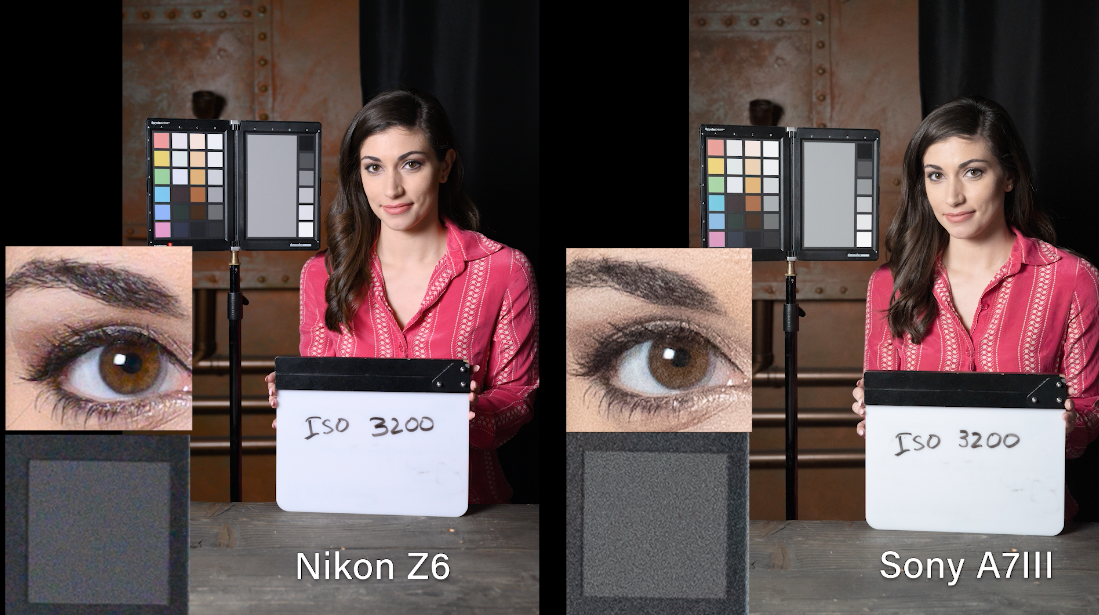 ISO 3200
ISO 3200
You really see the grain on the Sony now, and a little bit of it occurring in the Nikon.
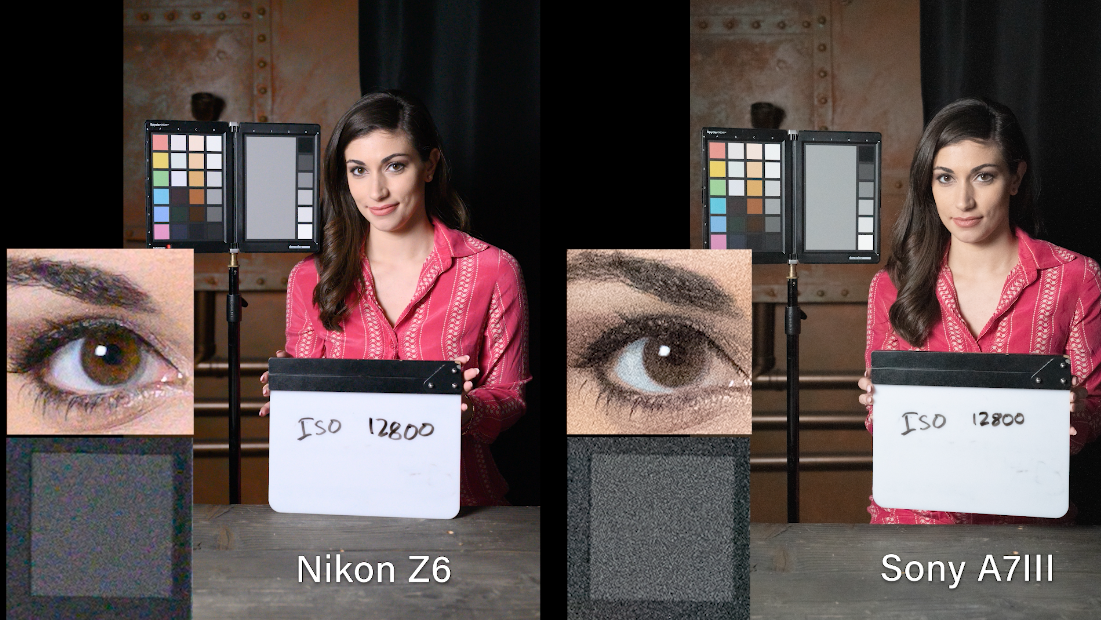 ISO 12800
ISO 12800
The grain is apparent on both of the cameras, but it’s definitely more colorful on the Nikon Z6. As you can see, Sony has a lot of grain in the image, but not as much color building.
Autofocus Test
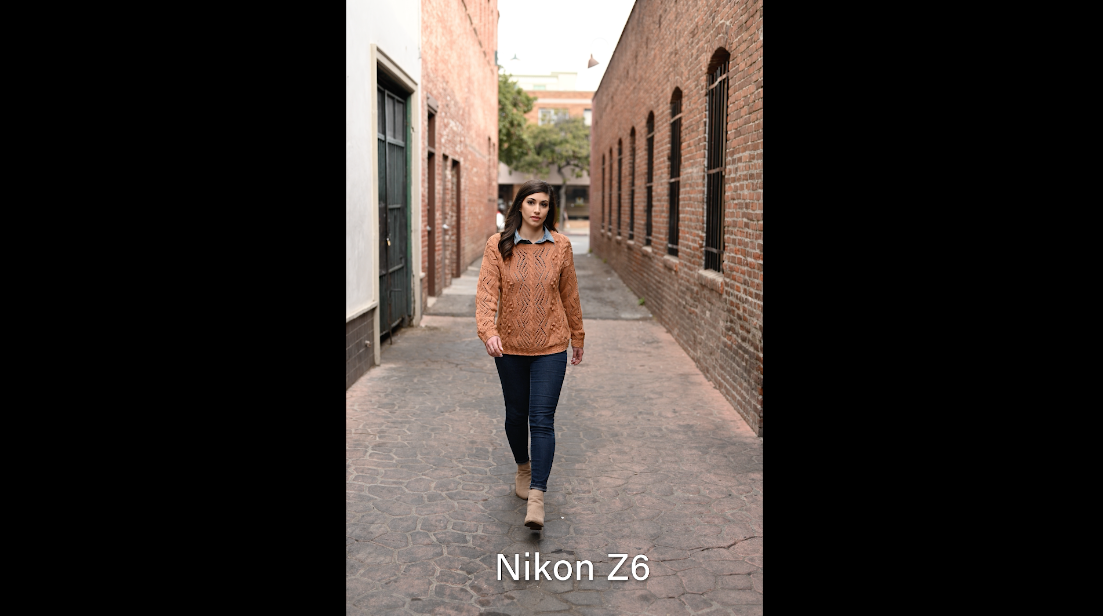 We perform this test by having a model walk straight toward us, and see how well the camera can focus on a moving object, as it gets closer.
We perform this test by having a model walk straight toward us, and see how well the camera can focus on a moving object, as it gets closer.
The Nikon Z6 did really well even though it doesn’t have their face detection technology. It has a generic tracking that it uses for focusing. There were a couple of frames that were a little soft, but overall it held up pretty well. 95% of them were in focus.
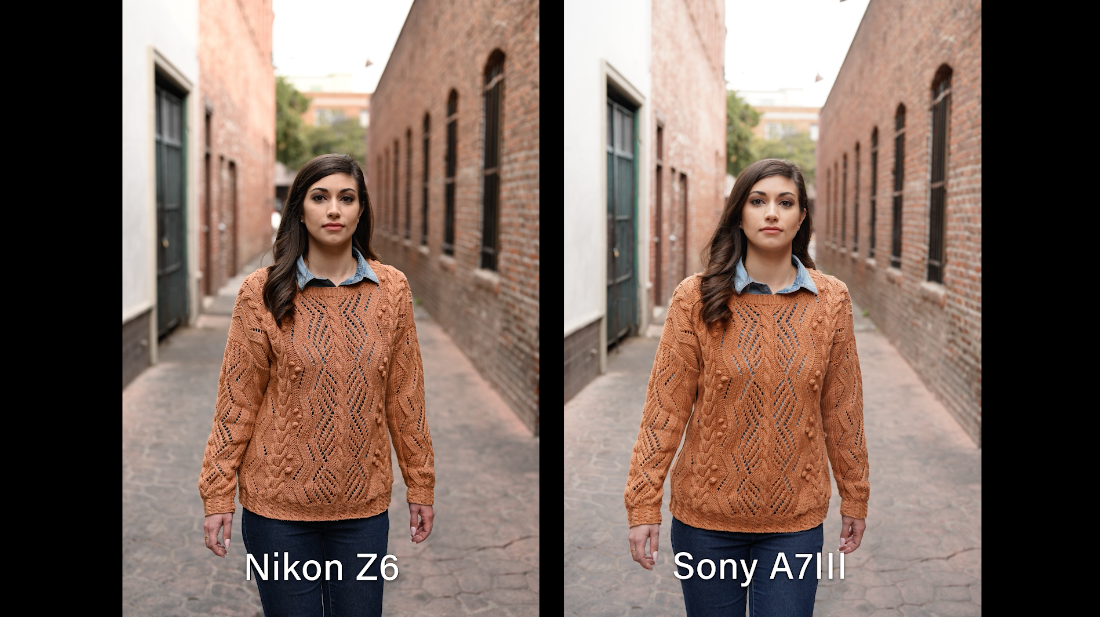 We’ve tested the Sony A7III before with this test, and it didn’t perform as well in the test we did today. The beginning half of the images were a bit soft. This may be because the eye detection couldn’t track the subject from so far away. Once she got closer though, the images were a lot sharper and focused on her.
We’ve tested the Sony A7III before with this test, and it didn’t perform as well in the test we did today. The beginning half of the images were a bit soft. This may be because the eye detection couldn’t track the subject from so far away. Once she got closer though, the images were a lot sharper and focused on her.
Texture and Resolution
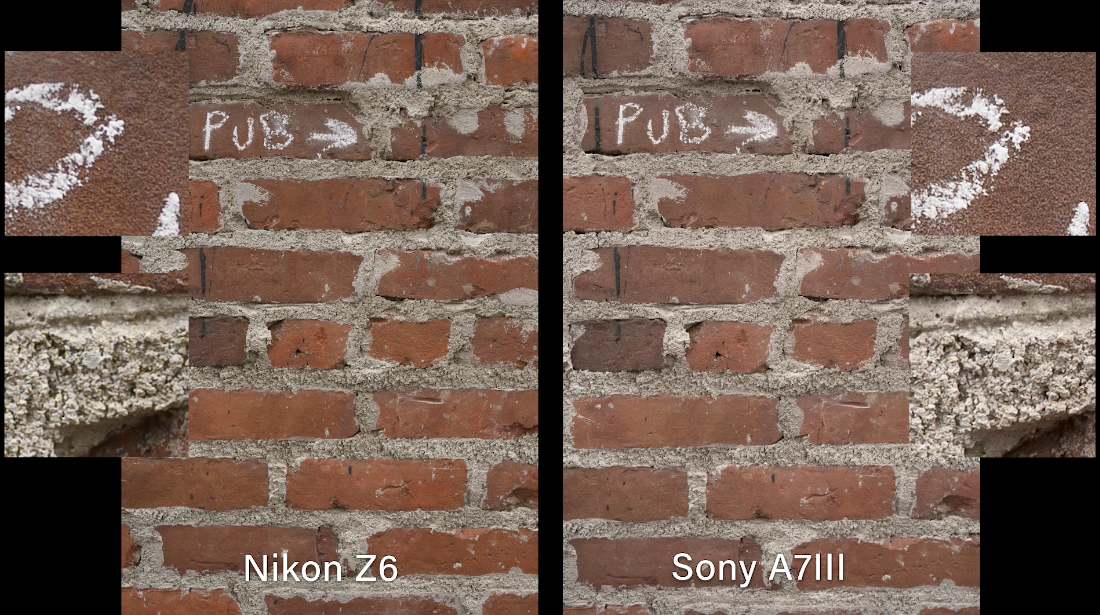 My first thought when I saw these two images was that the Sony A7III was a little bit sharper with a little more detail. Megapixel-wise they are within .5 px of each other, so they are both really great resolution quality.
My first thought when I saw these two images was that the Sony A7III was a little bit sharper with a little more detail. Megapixel-wise they are within .5 px of each other, so they are both really great resolution quality.
Video Quality
 Both of these cameras can shoot in 4K up to 30 frames and they also both do 120FPS at 1080p, so we decided to test out how they match up in video quality. The interesting thing about mirrorless cameras is that they can vary greatly in video quality in terms of compression.
Both of these cameras can shoot in 4K up to 30 frames and they also both do 120FPS at 1080p, so we decided to test out how they match up in video quality. The interesting thing about mirrorless cameras is that they can vary greatly in video quality in terms of compression.
Nikon’s really aren’t built for video, and this image is about what I would have expected. The Nikon Z6 image looks over sharpened with heavy contrast, whereas Sony has a softer look with a more natural color.
High Frame Rate
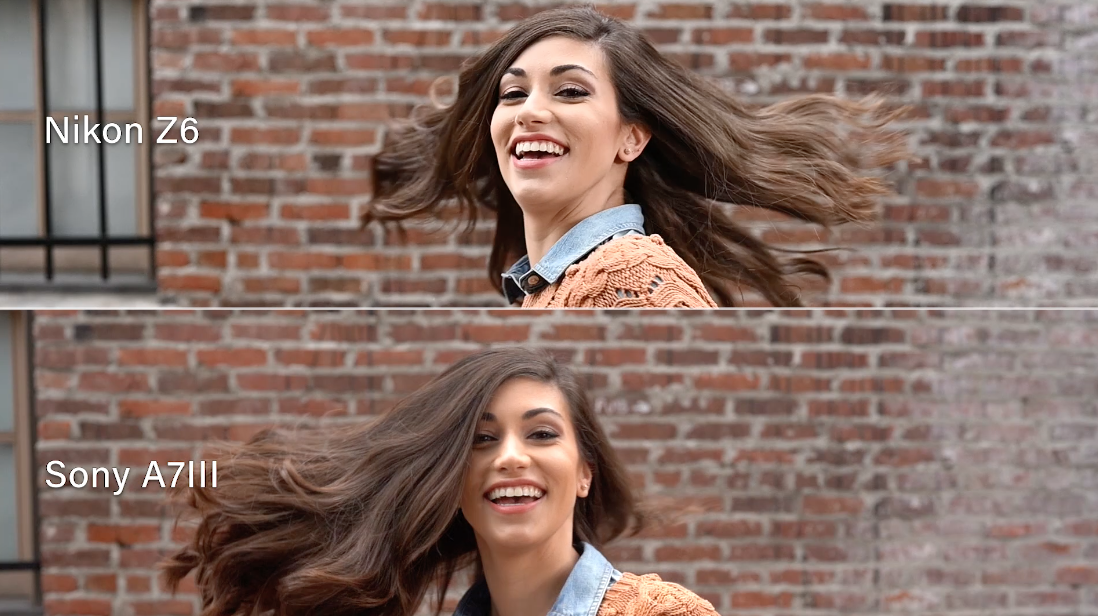 The Nikon video looks pretty solid in terms of sharpness and clarity in the video, but the video quality just looks over dealt with and very harsh. The Sony A7III has a flatter image in general, but it keeps a lot of fine detail in the hair.
The Nikon video looks pretty solid in terms of sharpness and clarity in the video, but the video quality just looks over dealt with and very harsh. The Sony A7III has a flatter image in general, but it keeps a lot of fine detail in the hair.
Conclusion
The Nikon Z6 is a great camera if you are planning on shooting photography. The picture quality, color rendition, and ease of use are great, but for shooting video I’m going to have to go with the Sony. These two cameras are really similar, but you have to make a decision on which one is best for you! Let us know which one you would choose for camera needs and why.
Shop Jay P’s Gear: https://www.amazon.com/shop/theslantedlens
Jay P’s Gear @ B&H: https://bhpho.to/2ES90Eb
GEAR USED:
(NEWLY RELEASED) Datacolor Spyder X Elite
B&H: https://bhpho.to/2N10UKV
Nikon Z6
B&H: https://bhpho.to/2CeuZBr
Amazon: https://amzn.to/2M5NaxR
Sony A7III
B&H: https://bhpho.to/2SKcQ9b
Amazon: https://amzn.to/2IdCa3b
Nikor S 50mm f1.8
B&H: https://bhpho.to/2Svhnfu
Amazon: https://amzn.to/2GCa13m
Sony Zeiss 50mm f1.4
B&H: https://bhpho.to/2rma0rm
Amazon: https://amzn.to/2E8i5qY
BlackRapid Classic Strap
B&H: https://bhpho.to/2G06Y1T
Amazon: https://amzn.to/2TKGMPv
Illuminati Light and Color Meter
B&H: https://bhpho.to/2ycApee
Amazon: https://amzn.to/2X7QH3Y
Vanguard Alta Pro 2+ Tripod
B&H: https://bhpho.to/2N4XjLz
Amazon: https://amzn.to/2TMWaLc
